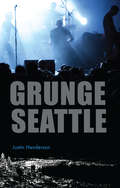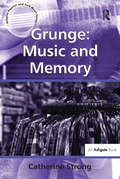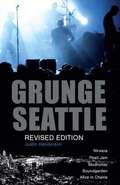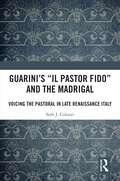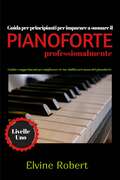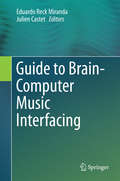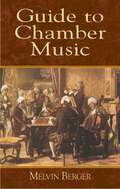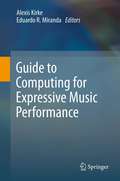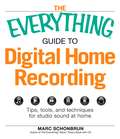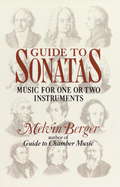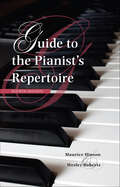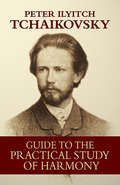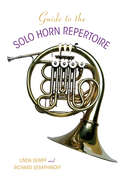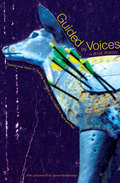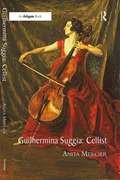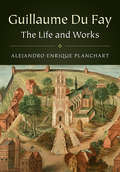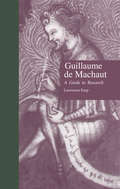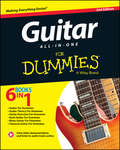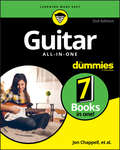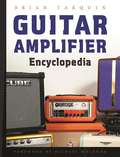- Table View
- List View
Grunge Seattle
by Justin HendersonDetailing the intertwined lives of members of core grunge bands, this thoroughly researched account reveals the origins and inspirations of the grunge music movement. Illustrating the dramatic and emotional tensions that arose between the various players, it describes the collisions between personalities and egos, artists and corporations, suburbs and cities, obscurity and fame. It is also a unique guide to the key locations in the grunge story, exploring the cafes, apartments, and studios where members of bands such as Nirvana, Pearl Jam, Soundgarden, Mudhoney, and Alice in Chains practiced and played.
Grunge Seattle
by Justin HendersonChronicling the intertwined lives of members of core grunge bands, Grunge Seattle reveals the origins and inspirations of the grunge movement. Delve into the collisions between personalities and egos, artists and corporations, suburbs and cities, obscurity and fame. Explore the cafés, apartments and studios where Nirvana, Pearl Jam, Soundgarden, Mudhoney and Alice in Chains practiced and played. In this reprint edition, originally published in 2010 and revised in 2016, writer, surfer and longtime Seattlite Justin Henderson provides a unique guide to the key locations in the story of grunge.
Grunge: Music And Memory (Ashgate Popular and Folk Music Series)
by Catherine StrongGrunge has been perceived as the music that defined 'Generation X'. Twenty years after the height of the movement there is still considerable interest in its rise and fall, and its main figures such as Kurt Cobain and Courtney Love. As a form of 'retro' music it is even experiencing a resurgence, and Cobain remains an icon to many young music fans today. But what was grunge, and what has it become? This book explores how grunge has been remembered by the fans that grew up with it, and asks how memory is both formed by and forms popular culture. It looks at the relationship between media, memory and music fans and demonstrates how different groups can use and shape memory as part of an ongoing struggle for power in society. Grunge was the site of such a struggle, as popular music so often is, with the young people of the time asking questions about their place in the world and the way society is organized. This book examines what these questions were, and what has happened to them over time. It shows that although grunge challenged many social structures, the way it, and youth itself, are remembered often work to reinforce the status quo.
Grunge: Seattle
by Justin HendersonChronicling the intertwined lives of members of core grunge bands, Justin Henderson reveals the origins and inspirations of the grunge music movement. Illustrating the dramatic and emotional tensions that arose between the various players, he describes the collisions between personalities and egos, artists and corporations, suburbs and cities, obscurity and fame. The book is also a unique guide to the key locations in the grunge story, exploring the cafes, apartments, and studios where members of Nirvana, Pearl Jam, Soundgarden, Mudhoney, and Alice in Chains practiced and played. A new chapter explores the continuing influence of Grunge on music today.
Grétry's Operas and the French Public: From the Old Regime to the Restoration (Ashgate Interdisciplinary Studies in Opera)
by R.J. ArnoldWhy, in the dying days of the Napoleonic Empire, did half of Paris turn out for the funeral of a composer? The death of André Ernest Modeste Grétry in 1813 was one of the sensations of the age, setting off months of tear-stained commemorations, reminiscences and revivals of his work. To understand this singular event, this interdisciplinary study looks back to Grétry’s earliest encounters with the French public during the 1760s and 1770s, seeking the roots of his reputation in the reactions of his listeners. The result is not simply an exploration of the relationship between a musician and his audiences, but of developments in musical thought and discursive culture, and of the formation of public opinion over a period of intense social and political change. The core of Grétry’s appeal was his mastery of song. Distinctive, direct and memorable, his melodies were exported out of the opera house into every corner of French life, serving as folkloristic tokens of celebration and solidarity, longing and regret. Grétry’s attention to the subjectivity of his audiences had a profound effect on operatic culture, forging a new sense of democratic collaboration between composer and listener. This study provides a reassessment of Grétry’s work and musical thought, positioning him as a major figure who linked the culture of feeling and the culture of reason - and who paved the way for Romantic notions of spectatorial absorption and the power of music.
Guarini's 'Il pastor fido' and the Madrigal: Voicing the Pastoral in Late Renaissance Italy
by Seth J. ColuzziBattista Guarini’s pastoral tragicomedy Il pastor fido (1589) began its life as a play, but soon was transformed through numerous musical settings by prominent composers of the late sixteenth and early seventeenth centuries. Through the many lives of this work, this book explores what happens when a lover’s lament is transplanted from the theatrical stage to the courtly chamber, from speech to song, and from a single speaking character to an ensemble of singers, shedding new light on early modern literary and musical culture. From the play’s beginnings in manuscripts, private readings, and aborted stage productions in the 1580s and 1590s, through the gradual decline of Pastor fido madrigals in the 1640s, this book examines how this widely read yet controversial text became the center of a lasting and prolific music tradition. Using a new integrative system of musical-textual analysis based on sixteenth-century theory, Seth Coluzzi demonstrates how composers responded not only to the sentiments, imagery, and form of the play’s speeches, but also to subtler details of Guarini’s verse. Viewing the musical history of Guarini’s work as an integral part of the play’s roles in the domains of theater, literature, and criticism, this book brings a new perspective to the late Italian madrigal, the play, and early modern patronage and readership across a diverse geographical and temporal frame.
Guida per principianti per imparare a suonare il pianoforte professionalmente: Guida e suggerimenti per migliorare le tue abilità nel suono del pianoforte (Livelle Uno #1)
by Elvine RobertImpara a suonare il pianoforte, non per rimanere un mediocre, ma per diventare un professionista. Cliccando e leggendo di più, scopriresti che ciò che stavi cercando, lo hai sempre avuto davanti! Quando leggerai il primo libro di questa serie di libri guida per l'apprendimento professionale del pianoforte, rivolta ai principianti, imparerai come dare inizio all'utlizzo del tuo strumento preferito: •in che modo i 12 tasti si relazionano tra di essi; •i differenti modi di una scala e come suonare le scale maggiori e minori; •le tecniche di diteggiatura; •tecniche semplici e progressioni degli accordi; •le alterazioni degli accordi; •e molto altro! Con questo libro, potrai iniziare a suonare il pianoforte senza leggere gli spartiti. Questa serie darebbe inizio ad un grande viaggio verso l'apprendimento del pianoforte! NON PERDERE QUESTA GRANDE OCCASIONE, OTTIENI ADESSO LA TUA COPIA! Per ottenere la tua copia, scorri verso l'alto e clicca sul pulsante ACQUISTA o AGGIUNGI AL CARRELLO. Fa anche attenzione al LIVELLO DUE di questa serie di libri.!
Guide to Brain-Computer Music Interfacing
by Eduardo Reck Miranda Julien CastetThis book presents a world-class collection of Brain-Computer Music Interfacing (BCMI) tools. The text focuses on how these tools enable the extraction of meaningful control information from brain signals, and discusses how to design effective generative music techniques that respond to this information. Features: reviews important techniques for hands-free interaction with computers, including event-related potentials with P300 waves; explores questions of semiotic brain-computer interfacing (BCI), and the use of machine learning to dig into relationships among music and emotions; offers tutorials on signal extraction, brain electric fields, passive BCI, and applications for genetic algorithms, along with historical surveys; describes how BCMI research advocates the importance of better scientific understanding of the brain for its potential impact on musical creativity; presents broad coverage of this emerging, interdisciplinary area, from hard-core EEG analysis to practical musical applications.
Guide to Chamber Music
by Melvin BergerAuthoritative, beautifully written guide presents 231 of the most frequently performed pieces of chamber music by 55 composers. For each, the author gives a brief biography, followed by discussions of the individual compositions -- both their historical and musical contexts and their salient features, including formal organization, content, and any extramusical associations. "No lover of chamber music should be without this Guide." -- John Barkham Reviews. Preface. Glossary.
Guide to Computing for Expressive Music Performance
by Eduardo R. Miranda Alexis KirkeThis book discusses all aspects of computing for expressive performance, from the history of CSEMPs to the very latest research, in addition to discussing the fundamental ideas, and key issues and directions for future research. Topics and features: includes review questions at the end of each chapter; presents a survey of systems for real-time interactive control of automatic expressive music performance, including simulated conducting systems; examines two systems in detail, YQX and IMAP, each providing an example of a very different approach; introduces techniques for synthesizing expressive non-piano performances; addresses the challenges found in polyphonic music expression, from a statistical modelling point of view; discusses the automated analysis of musical structure, and the evaluation of CSEMPs; describes the emerging field of embodied expressive musical performance, devoted to building robots that can expressively perform music with traditional instruments.
Guide to Digital Home Recording: Tips, Tools, and Techniques for Studio Sound at Home (The Everything )
by Marc SchonbrunLeona Lewis, Lily Allen, and Colbie Caillat all became famous after their self-produced music was posted on the Internet. And now anyone who’s ever practiced in front of the mirror for hours wants to try it too. This guide shows aspiring musicians how to turn their computers into a music studio.Professional musician Marc Schonbrun leads you step-by-step through the basics of home recording, including:Tips on how to make—and stick to—a recording budgetThe best digital recording softwareMicrophones, mixers, and electronic hardwareRecording for individual instruments and virtual instrumentsMixing, mastering, and advanced recording techniquesFor a fraction of the cost of recording, you can become their own engineers. You’ll learn to create tracks complete with digital effects, virtual instruments, and sound quality that rival professional studios. In no time, you’ll be ready for your time in the spotlight!
Guide to Score Study for the Wind Band Conductor
by Frank Battisti Robert GarofaloThis outstanding "one-of-a-kind" text was designed to assist the conductor in achieving a personal interpretation of music.
Guide to Sonatas
by Melvin BergerWith the same authority, insight, and unique ability to bring music to life on the printed page that he brought to his Guide to Chamber Music, Melvin Berger gives us an indispensable guide to the sonata form. Comprehensive, analytical, and historical, including descriptions in nontechnical language of over two hundred of the best best-known sonatas, Guide to Sonatas is designed to help all music lovers--casual listeners, experienced concertgoers, performers, conductors, or teachers--deepen their understanding and enhance their enjoyment of the classical repertoire.
Guide to the Contemporary Harp
by Mathilde Aubat-Andrieu Laurence Bancaud Aurélie Barbé Hélène BreschandHarps and harp music have enjoyed a renaissance over the past century and today can be heard in a broad array of musical contexts. Guide to the Contemporary Harp is a comprehensive resource that examines the vibrant present-day landscape of the harp. The authors explore the instrument from all angles, beginning with organology; moving through composition, notation, and playing techniques; and concluding with the contemporary repertoire for the harp. The rapid diversification in these areas of harp performance is the result of both technological innovations in harp making, which have produced the electric harp and MIDI harp, and innovative composers and players. These new instruments and techniques have broadened the concept of what is possible and what constitutes harp music for today. Guide to the Contemporary Harp is an essential guide for any harpist looking to push the instrument and its music to new heights.
Guide to the Pianist's Repertoire (Indiana Repertoire Guides)
by Maurice Hinson Wesley RobertsGuide to the Pianist's Repertoire continues to be the go-to source for piano performers, teachers, and students. Newly updated and expanded with more than 250 new composers, this incomparable resource expertly guides readers to solo piano literature and provides answers to common questions: What did a given composer write? What interesting work have I never heard of? How difficult is it? What are its special musical features? How can I reach the publisher? New to the fourth edition are enhanced indexes identifying black composers, women composers, and compositions for piano with live or recorded electronics; a thorough listing of anthologies and collections organized by time period and nationality, now including collections from Africa and Slovakia; and expanded entries to account for new material, works, and resources that have become available since the third edition, including websites and electronic resources. The "newest Hinson" will be an indispensible guide for many years to come.
Guide to the Practical Study of Harmony (Dover Books on Music)
by Peter Ilyitch TchaikovskyWritten during Tchaikovsky’s years as professor at the renowned Moscow Conservatory, this volume presents a clear and thorough introduction to the study of harmony. The great Russian composer expounded upon his views of music while he was in the full flower of his creative powers, offering students a chance to learn the discipline’s fundamentals from one of its great masters. Out of print for decades and exceedingly rare in its original edition, Tchaikovsky’s Guide to the Practical Study of Harmony possesses an intrinsic historical interest, yet remains as useful and instructive today as it was a century ago. A complete course in writing music, this excellent manual features numerous examples and exercises. It functions equally well as a classroom text, an adjunct to private instruction, or as a guide to individual musicians.
Guide to the Solo Horn Repertoire
by Richard Seraphinoff Linda DempfThis comprehensive, annotated resource of solo repertoire for the horn documents in detail the rich catalogue of original solo compositions for the instrument. Intended as a guide for practical use and easy reference, it is organized into three large sections: works for unaccompanied horn, works for horn and keyboard, and works for horn and ensemble. Each entry includes publisher information, a brief description of the form and character of a work, technical details of the horn writing, and information on dedication and premiere. The authors also include commentary on the various techniques required and the performance challenges of each piece. Representing over ten years of careful compilation and notation by an expert in horn performance and pedagogy, and by a seasoned music librarian and natural horn performer, Guide to the Solo Horn Repertoire will be an invaluable resource for performers, educators, and composers.
Guided by Voices: A Brief History
by James GreerThe true story of the fourth-grade teacher in Dayton, Ohio, who created one of the most influential bands of our times. Devoted fans have followed Guided by Voices for decades—and critics around the world have lauded the band’s brain trust, Robert Pollard, as a once-in-a-generation artist. Pollard has been compared by the New York Times to Mozart, Rossini, and Paul McCartney (in the same sentence) and everyone from P. J. Harvey, Radiohead, R.E.M., the Strokes, and U2 has sung his praises and cited his music as an influence. But it all started rather prosaically when Pollard, a fourth-grade teacher in his early thirties, began recording songs with drinking buddies in his basement. In this book, James Greer, an acclaimed music writer and former Spin editor—who also played in the band for two years—provides unparalleled insight and complete access to the workings of Pollard’s muse.
Guilhermina Suggia: Cellist
by Anita MercierBorn in 1885 in Porto, Portugal, to a middle-class musical family, Guilhermina Suggia began playing cello at the age of five. A child prodigy, she was already a seasoned performer when she won a scholarship to study with Julius Klengel in Leipzig at the age of sixteen. Suggia lived in Paris with fellow cellist Pablo Casals for several years before World War I, in a professional and personal partnership that was as stormy as it was unconventional. When they separated Suggia moved to London, where she built a spectacularly successful solo career. Suggia's virtuosity and musicianship, along with the magnificent style and stage presence famously captured in Augustus John's portrait, made her one of the most sought-after concert artists of her day. In 1927 she married Dr Jos asimiro Carteado Mena and settled down to a comfortable life divided between Portugal and England. Throughout the 1930s, Suggia remained one of the most respected musicians in Europe. She partnered on stage with many famous instrumentalists and conductors and completed numerous BBC broadcasts. The war years kept her at home in Portugal, where she focused on teaching, but she returned to England directly after the war and resumed performing. When Suggia died in 1950, her will provided for the establishment of several scholarship funds for young cellists, including England's prestigious Suggia Gift. Mercier's study of Suggia's letters and other writings reveal an intelligent, warm and generous character; an artist who was enormously dedicated, knowledgeable and self-disciplined. Suggia was one of the first women to make a career of playing the cello at a time when prejudice against women playing this traditionally 'masculine' instrument was still strong. A role model for many other musicians, she was herself a fearless pioneer.
Guillaume Du Fay: The Life and Works
by Alejandro PlanchartThis volume explores the work of one of medieval music's most important figures, and in so doing presents an extended panorama of musical life in Europe at the end of the middle ages. Guillaume Du Fay rose from obscure beginnings to become the most significant composer of the fifteenth century, a man courted by kings and popes, and this study of his life and career provides a detailed examination of his entire output, including a number of newly discovered works. As well as offering musical analysis, this volume investigates his close association with the Cathedral of Cambrai, and explores how, at a time when music was becoming increasingly professionalised, Du Fay forged his own identity as 'a composer'. This detailed biography will be highly valuable for those interested in the history of medieval and church music, as well as for scholars of Du Fay's musical legacy.
Guillaume de Machaut: A Guide to Research (Composer Resource Manuals Ser. #Vol. 36.)
by Lawrence EarpThis book provides an overview of the current state of research on Machaut, the major figure of 14th-century French music and poetry, giving fair representation to the many areas of Machaut research that are pursued in fields outside music.Coverage of the current state of knowledge on each of the manuscripts includes the newly discovered Aberystwyth manuscript, described in detail here for the first time. A section on the large narrative poems pulls together recent research of several scholars and offers new views. An up-to-date concordance of the miniatures in all of the illustrated Machaut manuscripts gives information on where published studies and facsimiles may be found. The discography is the most complete list of Machaut recordings yet compiled and provides critical evaluations of recordings most valuable for instruction, according to our latest conception of performance practice in the 14th-century.A biography section organizes the documentary material in a way that will facilitate further research. The bibliography of secondary works cites books, editions, articles, and dissertations (including forthcoming works) from 1740 to 1991, in French, English, the other western European languages, Polish, Russian, and Japanese. The volume is fully indexed.
Guitar (Eureka! The Biography of an Idea)
by Lori Haskins HouranTurn it up! The newest addition to the nonfiction Eureka! series is a &“biography&” of guitars, an essential invention that gets people rocking.With a timeline spanning from the first time someone strummed a string stretched across a hollow object to electric guitars that bring stadiums of people to their feet today, Guitar is a fun and informative look at the development of an invention that adds music to our lives. This STEAM nonfiction title is part of the Eureka! series, with each book focusing on one groundbreaking, world-changing discovery that millions of people use every single day.
Guitar All-In-One For Dummies
by Hal Leonard Corporation Mark Phillips Jon Chappell Desi SernaMake your music come alive with this indispensable guitar guide There's no denying that guitar players have cachet. The guitar is an ever-present part of our collective musical heritage, and the sound can be sensual, aggressive, or a million things in between. Whether you're hoping to conquer Free Bird, Bourée, or Bolero Mallorquin, you need to learn to walk before you can run. Even once you can run, you need something to help you clear hurdles along the way. That's where Guitar All-In-One For Dummies, 2nd Edition, comes in. It's your complete compendium of guitar instruction, written in clear, concise For Dummies style. It covers everything from positioning and basic chords to guitar theory and playing styles, and even includes maintenance advice to keep your instrument sounding great. It's an amazing resource for newbies and veterans alike, and offers you the opportunity to stretch beyond your usual genre. Forge the sound of rock, blues, classical, and more Understand the music theory behind guitar mastery Express yourself through your own compositions Perform practice exercises for muscle memory and dexterity Guitar All-In-One For Dummies, 2nd Edition, includes access to audio tracks and instructional videos to guide you through the lessons and inspire you to play often, which is the number-one key to success. You get advice and instruction from some of the most respected guitar teachers in the business, plus online resources, for less than the cost of a single lesson. Guitar All-In-One For Dummies, 2nd Edition, is the key to bringing your music to life.
Guitar All-in-One For Dummies: Book + Online Video and Audio Instruction
by Hal Leonard Corporation Mark Phillips Jon Chappell Desi Serna7 Books in one! Go from the basics to the style you want to play Making beautiful music with your acoustic or electric guitar requires practice, patience, and perseverance. A little guidance helps get you on the path to imitating the sounds of your guitar heroes. This friendly guide shares how to get the most out of your time with your guitar. Discover the fundamentals of strumming and playing chords and get an understanding of guitar theory, then delve into the secrets of playing rock, blues, or even classical styles. 7 Books Inside… Learning the anatomy of your guitar Starting with guitar fundamentals Refining your sound and technique Getting to know guitar theory Cranking up your rock guitar style Wailing with the blues Building your classical skills
Guitar Amplifier Encyclopedia
by Brian Tarquin Michael MolendaThis book is for the fans of guitar amplifiers and the history that lies behind them. Starting with early amp models like the Gibson EH-150 that was first used with Gibson's EH-150 lap-steel guitar and later the Charlie Christian ES-150 guitar, it then delves into the development of Fender, Vox, and Orange amps, and goes right up to the modern boutique designers like Industrial, Dr. Z, Fargen and Fuchs. Also featured are such tube amp classics as the Seymour Duncan Convertible head, ahead of its time in offering tube-switching before THD Amps existed. Other amp designers profiled include: Carvin Danelectro/Silvertone Engel Epiphone Premier Roland Seymour Duncan And many, many more! Emmy Award-winning guitarist, composer, and producer Brian Tarquin takes on the unique subject matter of the electric guitar's sidekick and partner-in-crime to create this informative and enthralling reference guide. Interviews with various amp makers as well as players, and a foreword by Michael Molenda (Guitar Player magazine), will all bring the reader closer to those glowing tubes and tones. Guitar Amplifier Encyclopedia provides an expansive education on all the best amps' every nuance, and how they each changed the history of sound!Allworth Press, an imprint of Skyhorse Publishing, publishes a broad range of books on the visual and performing arts, with emphasis on the business of art. Our titles cover subjects such as graphic design, theater, branding, fine art, photography, interior design, writing, acting, film, how to start careers, business and legal forms, business practices, and more. While we don't aspire to publish a New York Times bestseller or a national bestseller, we are deeply committed to quality books that help creative professionals succeed and thrive. We often publish in areas overlooked by other publishers and welcome the author whose expertise can help our audience of readers.

